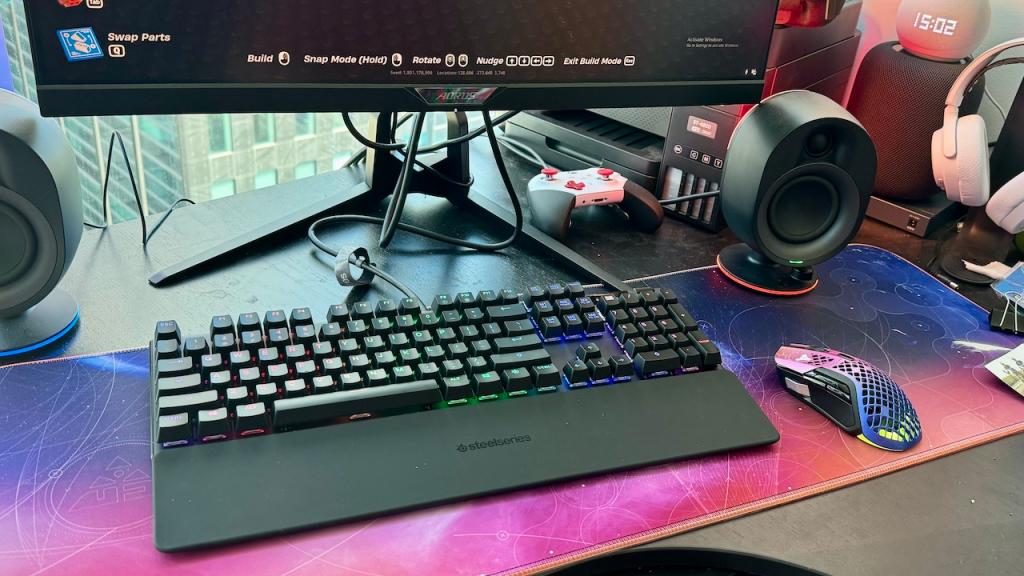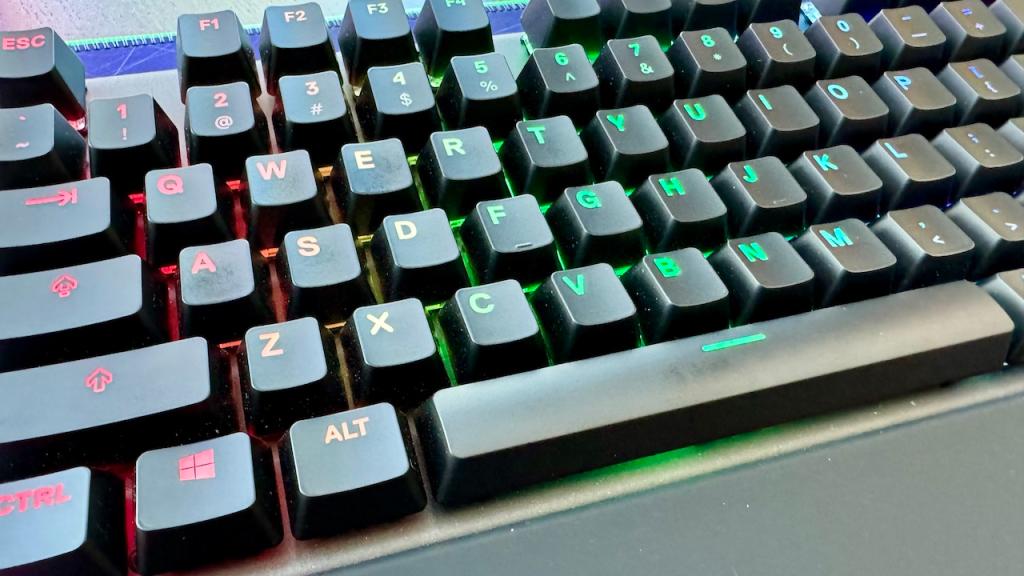Keyboards are incredibly personal devices. For people who spend a lot of time at their computers (almost everyone), they become like an extension of our hands. They are the fancy fountain pen set of the new millennium. They’re a huge factor in just how messed up our arthritis is going to be when we’re older. I recently switched the keyboard on my gaming PC from a very clicky Cherry Red switch-based keyboard, to a SteelSeries Apex Pro, which features “OmniPoint 2.0 Adjustable HyperMagnetic Switches” (which I am going to shorten to OmniPoint, because that is an obnoxiously long name). Cherry Red is more tactile, but the OmniPoint switches allow for more customisation which makes me a slightly more competent gamer, and less typo-committing writer and sometimes that’s enough.
Of course, being the fancy fountain pen set for our generation, the SteelSeries Apex Pro is very expensive. So, is it worth $439?
What is the SteelSeries Apex Pro keyboard?
The SteelSeries Apex Pro keyboard is basically the fanciest keyboard SteelSeries makes. It has all of the bells and whistles. Obviously, it has RGB lighting, because I think there’s a law against making anything for gamers that can’t light up in the widest variety of queer pride flags possible, and I appreciate that.
The most important features, though, are the fancy OmniPoint switches and the little OLED screen above the numpad.
You can see the specs below.
| Switch | OmniPoint 2.0 Adjustable HyperMagnetic Switches (Analog Hall Effect Magnetic Sensor) |
| Illumination | Dynamic Per Key RGB Illumination |
| Compatibility | Windows, Xbox, PlayStation, and Mac OS X*. USB port required *Not all software features supported on Mac OS |
| Lifetime | 100 Million Keypresses |
| Dimensions | 40.3 mm X 436.7 mm X 139.2 mm (HxWxD) |
| Actuation Point | 0.1 mm to 4.0 mm |
| Force | 45cN |
| Response time | 0.7 ms |
| Top material | Aircraft Grade Aluminum Alloy Frame |
| N-Key Roll Over | 104 Key |
| Anti-Ghosting | 100% |
OLED Screen? On a keyboard?
When I saw the little OLED screen on the keyboard, I thought it was going to be so useful and that I was going to take advantage of it so much. And then I got it and realised that I do not look down at the keyboard while I’m playing, and the screen doesn’t really do much for the games I play most often (Forza, Fortnite). It is good for changing between profiles, and for seeing the stats of your PC, if those are things that you want to do.
I’ve currently got it showing the status of various components in my computer, which is good for managing load. But it’s a nice to have, rather than an essential for most users. Maybe you’ll take better advantage of it than I do, because it is cool.
What’s the deal with Omnipoint 2.0 Adjustable HyperMagnetic Switches?

I was originally suspicious of these switches. I normally love clicky and abhor any suggestion of sponginess. And yet, the versatility of these switches has won me over. The most used 61 keys on the board are OmniPoint, while the others are Cherry MX Red. What makes the OmniPoint switches special is how customisable they are. You can choose the actuation point, and make the keys perform two different functions depending on how hard you press them. When I play Fortnite, I have it so a gentle press of W is walk, and a full press is sprint. It’s such a simple thing, but it makes a big difference. I can see this also being a handy feature for accessibility.
You can also adjust the actuation point down as low as 0.4mm to as high as 4.0mm, in 10 increments. This is good for both comfort, faster reaction times on games that rely on twitch reflexes, and fewer mis-clicks on games that demand precision.
The OmniPoint switches are also supposedly more durable, because they use magnets instead of physical switches. I haven’t’ had this keyboard long enough to put the 100 million click claim to the test, but it seems good so far. I’ll update you in a few years.
I found using them to be smooth. It did take a period of adjustment, because they are ever so slightly spongier than I was used to on my previous more tactile switches, so presses took a touch more effort. But the trade-off seems more than worth it.
For typing, dialling in the actuation distance let me fine tune the way I wrote in a way that I’m not used to and will demand from now on. I found that I was able to cut down on typos by adjusting the distance, but also reduce fatigue by finding that goldilocks zone. It’s a gamechanger for more than just games.
What else is good?
I’ve previously stayed away from SteelSeries keyboards because one I used years ago had an uncomfortable wrist wrest, so I was a little hesitant to move from my old keyboard’s spongey comfort cloud situation. But, while this rest is a bit harder than I’m used to, the rubberised top makes it much, much comfier than it looks. It’s just the right amount of softness.
It was also nice and easy to adjust the keyboard to a height that felt right for me, with the little feet at the back. The feet only do two heights (and off, so three, I guess), but that was enough for my needs.
Another thing I really like about the Apex Pro is that it has a couple of thoughtful little features, like cable management, a volume dial (which can also be used to select things on the OLED screen) and USB passthrough.
SteelSeries Apex Pro verdict

This is the kitchen sink of keyboards. It’s massive overkill for everyone but the most dedicated esports players, and yet you want one. It is very expensive, there’s no getting around that (though occasionally it’s on sale for $100 off, so you might get lucky at the sales, but even on sale, that’s a lot). But those OmniPoint switches seem like they would be pretty pricey to make, and they’re absolutely worth it for people who spend a lot of time using their keyboards and think they would benefit from being able to individually customise the actuation distance of each of the main keys.
It’s a keyboard for people who know exactly what they want, and are particular in their tastes. It’s not too loud or too quiet, it’s built like a tank (so it’ll probably last for a while, though I’m not sure what the point of putting aircraft-grade aluminium in there is), and it encourages you to be particular and make it just how you like it.
Whether or not you need it is down to you. But damn is it good.
